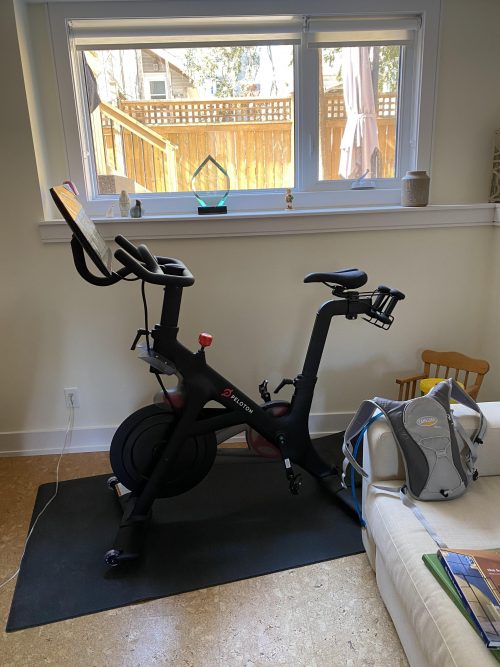A friend asked me if I had learned anything about how to live with cancer. I laughed — the “live with” part is still in play — but I’ll try to give a helpful answer.
That answer is: Even when you are very sick, do your best to maintain your health by getting or staying fit.
I need to apologize for that answer because it may be out of reach for many readers. I can focus on fitness because more important things have gone well for me:
- Connection. I have spent lots of time with my wife, children, and friends. Sadly, my kids and many of my friends live in the States, and the pandemic has closed the border. So I haven’t been in the same room with them in a year. However, being sick has freed large blocks of time. That gift of time was generously matched by my friends and family, who have spent hours with me on Zoom.
- Religion. We are Christians. For better or worse, cancer might scare me a bit less than you expect it to. Secular readers: Go ahead and deduct 15 points from your estimate of my IQ. I don’t mind.
- Canada. My out-of-pocket costs for my care have been about $100, for co-pays on an ambulance ride and some prescriptions for generic hydromorphone (trade name Dilaudid, a pain medication). Of course, my health care was not free. I prepaid through my taxes at a rate that reflected my income. The Canadian system gave me access to advanced cancer care without the slightest fear that it would bankrupt my family. Likewise, my employer immediately granted me months of paid disability leave. God save the Queen.
Without these foundations, I would surely have been overwhelmed. With them, I have maintained energy, mood, and purpose.
A few years ago, we lost a good friend to ovarian cancer that disseminated to her liver. She maintained her energy, dignity, and hospitality throughout the years of her illness. Part of her secret for thriving despite surgeries and chemotherapy was staying fit and upright through long daily walks with her friends and a standard poodle, which she logged on her Fitbit. Witnessing her exemplary life helped prepare us for my cancer.
I won’t cure my cancer through exercise (or diet, meditation, or prayer); this is how I live with it. I’m not ‘fighting’ cancer; that’s the Cancer Centre’s job. My job is to stay mobile, attend to my daily needs, care for those I love, write a bit, and prevent depression. Fitness is a means to those ends.
You get fit by developing a workout discipline. You don’t get disciplined by gritting your teeth, or at least not just by doing that. Workout discipline comes from joining a team, getting good coaching, evolving a program, and accurately monitoring your effort. Instead of a standard poodle and a Fitbit, I have a King Shepherd puppy and Peloton.

Mika joined our family in late June, just three days before I was diagnosed. Dogs are ideal teammates. The anthropologist Pat Shipman argues that the domestication of wolves to collaborate on hunts for large mammals enabled homo sapiens to outcompete the neanderthals for the apex predator niche in the Pleistocene. Mika loves to be with me, and she never gets bored. She unfailingly prompts me at walk time. She has a sweet disposition but can destroy anything if she doesn’t get multiple daily walks. Get a dog and, if you can, get a good trainer to help raise her.
The Peloton bike arrived on October 12, about a month after the end of radiation therapy but perhaps only a week after the physical experience’s nadir (radiation toxicity accumulates for weeks past your last session).

The bike is overpriced, but what makes it superior to the standard gym stationary bike is the touchscreen display of your pedalling cadence, resistance, power (the watts/joules you are generating), and their averages. Your workout data are saved to the cloud, maintained in an easily accessible history, with lots of graphs and notifications to track your progress. Every fitness app does this kind of thing, but Peloton does it better than anything else I’ve tried.

The Peloton brand is online spin classes, but that’s not the best way to think about it. Peloton has a touchscreen-equipped treadmill, as well as outdoor running, strength training, yoga, pilates, barre, stretching, and meditation classes that you can access from your phone or tablet. The instructors encourage you to cross-train, which is crucial. Trust me: if cycling is all you do, you will injure yourself. There is a huge library of recorded modular workouts of 5 to 90 minutes that you can do any time. Use these like Lego blocks to build a weekly fitness program. That sounds intimidating. However, although the instructors radiate spin class glamour, many of them are former physical therapists or strength/endurance coaches. Start by choosing workouts based on the music. You’ll absorb cross-training ideas from the instructors’ monologues and the prompts that follow the completion of a workout. What makes all this work is the pricing. You pay one monthly fee rather than paying by the class, so there is no disincentive to doing, for example, a 5-minute guided stretch after each ride.
Peloton has an active social network. The touchscreen has a camera, so if you do a live class, you can add a video chat with friends on the same ride. I haven’t explored this much, but I’d like to. I used to be an age group triathlete, and group rides were the core of my training (shout out to the Columbus Triathlon Club!).
Perhaps most importantly, the Peloton instructors supply good coaching at internet scale. I recommend Matt Wilpers and his PowerZone training,* but you can pursue lots of other tracks. PowerZone training gives you a method to tailor your workouts to your current fitness. If you are so sick that you can barely turn the pedals, that’s fine. PowerZone reconfigures your touchscreen to rescale the output wattage your pedals are generating to a scale anchored by 0 = no pedal rotation to 7 = a level of exertion that you can maintain for just seconds. The program has a procedure to set these zones to what you can do. Then, when you do a PowerZone class, the instructor calls out a zone, rather than an output wattage (or cadence or resistance) that might be impossible. This gives you a workout that is feasible — and, in measured doses, demanding — for you. The PowerZone workouts — interval training, in spin class drag — give you a path to build those capabilities.

Effective coaching at internet scale is an amazing accomplishment. It is what wellness programs promise but fail to deliver. Of course, Peloton — and dog ownership — succeed mostly because the people who commit to them already love dogs and want to be fit. Perhaps this selection effect is the entire story. Who cares? Select yourself in. Fitness will help you live with and recover from cancer.
*Matt Wilpers didn’t invent power zones. Professional cyclists and triathletes all train this way. What he has done is figure out how to teach and support this style of technical, instrumented cycling training for a mass audience.

